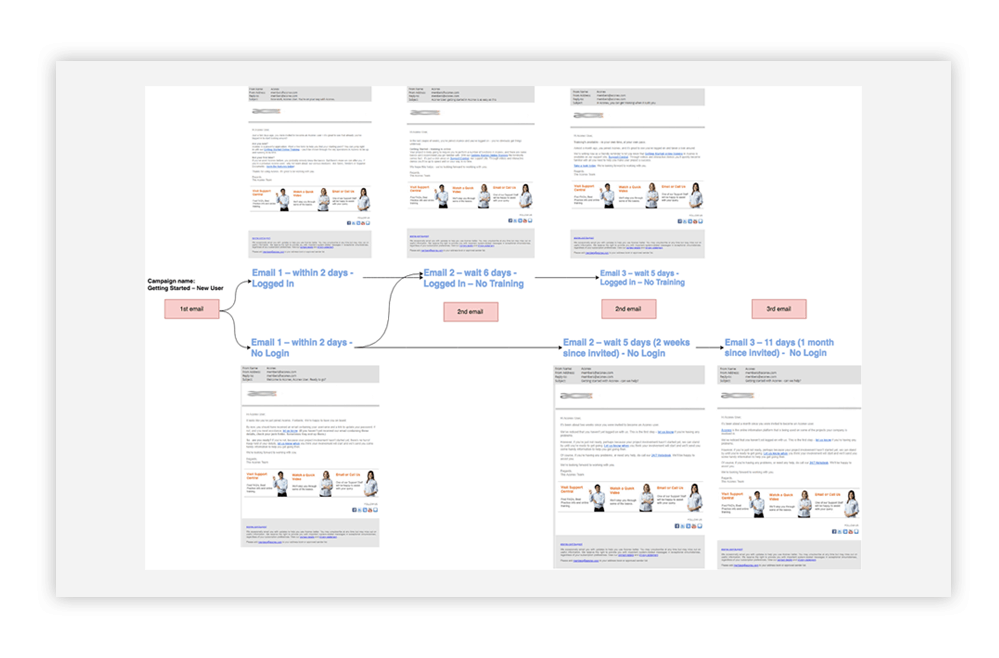The challenge: Clients were unsatisfied with the implementation and onboarding experience when switching to use the product, a global project management software. Net Promoter Score (NPS) surveys showed that implementation and first use experience were key factors that have most impacted low scores.
The project goal was to increase the percentage of users who are satisfied with first use and to reduce submitted support cases related to new users. The project team set to redesign and standardise the onboarding experience.
My role included a contribution to all aspects of the project, research with stakeholders, collecting and analysing usage data, creating a customer journey map and prototyping proposed solutions.
The process
Research
The first stage involved research on how the company currently onboards new organizations and users. For this, I collected quantitative data on the current user behaviour as a baseline for improvements.
Key findings
- A low percentage of new users visited and completed the current ~20 min online “getting started” training course. Our hypothesis was that people don’t want to spend that much time on training on how to use a new system.
- Current welcome emails had low open rates and low click-through rates. Our hypothesis for this was that the email subject line and call to actions needed to be more compelling and these emails should provide a more relevant bite-size information.

Mapping the current onboarding email flow
Mapping the current onboarding campaigns helped capture what we currently send to new users. It highlighted areas to improve and helped with the discussion on redesigning future campaigns.

What do new users care about?
Analysing data on the top support cases submitted by new users in their first 90 days, highlighted that users needed a lot more training and help with logging in, adding new users and joining a project in order to effectively engage with the system.

Journey Map
This included research with users who are responsible for training people in their organization to use the platform. Interviewing these people helped me understand their thoughts and feedback on the current process and training available: what works well, what doesn’t work and what can be done better.
This phase included interviews with internal staff members (Account Managers, Engagement Managers and Client Services Implementation Consultants) to understand the implementation process and what communication and training can be provided along the journey.
This led to the creation of an organization and user onboarding journey map. The onboarding journey map included:
- The steps a standard client would go through from signing a service order to starting to use the platform to manage their first project.
- Interactions & Touchpoints outlining the collateral used by client services teams in different regions to communicate with clients during the implementation process.
- Internal interactions include the steps the internal client services and support teams performed to support this process internally.
- Pain Points & Opportunities to improve the experience.

Key insights
The onboarding and implementation process is overwhelming for clients who are time poor and want everything done yesterday.
- Users don’t understand they have role-based permissions in the platform.
- The client gets lost, don’t know what is the best training for their team and would like clearer training paths.
- Missed opportunity to improve service and provide a chance of renewal post-implementation process
- Users invitation to a project flow in the app could be improved
Next steps
The journey map and insights from research led to designing a future state map. The findings from the research included recommendations to:
- Develop an onboarding playbook or welcome kit that can be given to consultants internally and shared with new clients.
- Improve the welcome emails and in-app messages.
- Redesign information architecture in the support site to better guide users through implementation, onboarding and training.
Future state map
Highlighted in yellow are enhancements that the company could develop to improve the experience for new clients and users.


UX Methods
- Interviews
- Analysing quantitative data
- Customer / User Journey Mapping
- Site Map and User Flows
- Information Architecture
- Prototyping